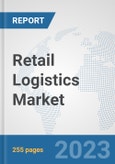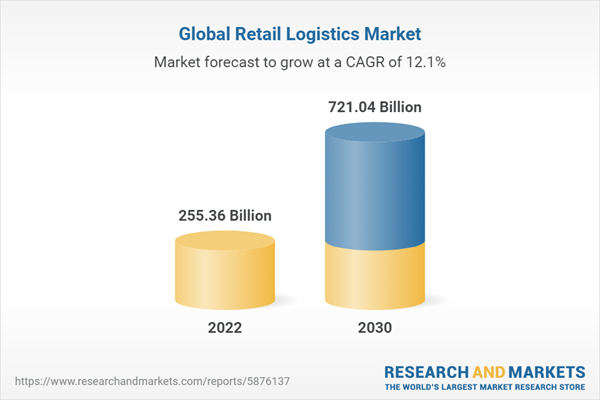The report on the global retail logistics market provides qualitative and quantitative analysis for the period from 2021-2030. The revenue generated by the market was USD 255.36 billion in 2022 and is expected to reach 721.04 billion in 2023, with a CAGR of 12.05% in the forecasted period 2023-2030. The study on retail logistics market covers the analysis of the leading geographies such as North America, Europe, Asia Pacific, and RoW for the period of 2021-2030.
The retail logistics market is set to experience robust growth driven by a confluence of factors that address both practical concerns. Furthermore, advancements in retail logistics technology have led to the creation of films that not only provide effective UV protection but also enhance the visual appeal of buildings and vehicles. Stricter regulations pertaining to energy efficiency and safety standards are propelling the integration of retail logistics into various applications. Furthermore, the growing awareness of the damaging effects of UV radiation on human health is fostering the demand for protective retail logistics that safeguard individuals and interiors alike. As urbanization and infrastructure development continue, the market is expected to experience sustained expansion, with a significant emphasis on incorporating innovative retail logistics solutions to meet evolving consumer and industry needs.
The use of road transport is expected to stay strong in the projected period. Owing to the growing need for effective ways to move retail goods over long distances, especially within a country. Trucks and cargo vehicles that can carry a lot of items are a great choice for stores. The government is also helping this by implementing rules. For instance, recent regulations from the Federal Motor Carrier Safety Administration advocate the replacement of traditional rear-view mirrors with cameras, heightening the safety quotient for truck drivers. Moreover, the upswing in demand for the roadway mode of transportation is steered by the amplifying road connectivity in developing nations and the well-established road infrastructure in developed countries. This augmented connectivity assumes a pivotal role in facilitating seamless product deliveries and pick-ups for retail logistics entities across myriad tier 2 and tier 3 cities spanning diverse nations. As constant advancements in road transportation systems persist and global highways undergo ongoing enhancements, this trend is anticipated to the dominance of roadways transport of retail logistics.
The Asia-Pacific (APAC) region stands as a global leader in the e-commerce sector, propelled by its sizable and youthful population skilled in technology usage. The Asia Pacific region hosts a continually expanding ecosystem of Small and Medium Enterprises (SMEs) that are wholeheartedly embracing e-commerce platforms to capitalize on business prospects. The APAC region has emerged as a pivotal force driving the transformation of supply chains. Considerable investments have been channelled into the establishment of state-of-the-art logistics facilities that represent the next generation of capabilities. In the APAC region established players in the market include stalwarts from the traditional logistics sphere, with names like DHL, DB Schenker, Ceva Logistics, Kuehne + Nagel, DSV, and Geodis occupying prominent positions which results in the dominance of APAC in the overall market.
2. Internal and External subject matter experts
3. Professionals and participants from the industry
2. Product/brand/marketing managers
3. CXO level executives
4. Regional/zonal/country managers
5. Vice President level executives.
2. Government/institutional publications
3. Trade and associations journals
4. Databases such as WTO, OECD, World Bank, and among others.
5. Websites and publications by research agencies
2. Complete coverage of all the segments in the retail logistics market to analyze the trends, developments in the global market and forecast of market size up to 2030.
3. Comprehensive analysis of the companies operating in the global retail logistics market. The company profile includes analysis of product portfolio, revenue, SWOT analysis and latest developments of the company.
4. Growth Matrix presents an analysis of the product segments and geographies that market players should focus to invest, consolidate, expand and/or diversify.
The retail logistics market is set to experience robust growth driven by a confluence of factors that address both practical concerns. Furthermore, advancements in retail logistics technology have led to the creation of films that not only provide effective UV protection but also enhance the visual appeal of buildings and vehicles. Stricter regulations pertaining to energy efficiency and safety standards are propelling the integration of retail logistics into various applications. Furthermore, the growing awareness of the damaging effects of UV radiation on human health is fostering the demand for protective retail logistics that safeguard individuals and interiors alike. As urbanization and infrastructure development continue, the market is expected to experience sustained expansion, with a significant emphasis on incorporating innovative retail logistics solutions to meet evolving consumer and industry needs.
The use of road transport is expected to stay strong in the projected period. Owing to the growing need for effective ways to move retail goods over long distances, especially within a country. Trucks and cargo vehicles that can carry a lot of items are a great choice for stores. The government is also helping this by implementing rules. For instance, recent regulations from the Federal Motor Carrier Safety Administration advocate the replacement of traditional rear-view mirrors with cameras, heightening the safety quotient for truck drivers. Moreover, the upswing in demand for the roadway mode of transportation is steered by the amplifying road connectivity in developing nations and the well-established road infrastructure in developed countries. This augmented connectivity assumes a pivotal role in facilitating seamless product deliveries and pick-ups for retail logistics entities across myriad tier 2 and tier 3 cities spanning diverse nations. As constant advancements in road transportation systems persist and global highways undergo ongoing enhancements, this trend is anticipated to the dominance of roadways transport of retail logistics.
The Asia-Pacific (APAC) region stands as a global leader in the e-commerce sector, propelled by its sizable and youthful population skilled in technology usage. The Asia Pacific region hosts a continually expanding ecosystem of Small and Medium Enterprises (SMEs) that are wholeheartedly embracing e-commerce platforms to capitalize on business prospects. The APAC region has emerged as a pivotal force driving the transformation of supply chains. Considerable investments have been channelled into the establishment of state-of-the-art logistics facilities that represent the next generation of capabilities. In the APAC region established players in the market include stalwarts from the traditional logistics sphere, with names like DHL, DB Schenker, Ceva Logistics, Kuehne + Nagel, DSV, and Geodis occupying prominent positions which results in the dominance of APAC in the overall market.
Report Findings
1) Drivers
- The surging demand for smartphones, and e-commerce services, driving the growth of the market.
- The increasing popularity of quick delivery services propelling the growth of the market.
2) Restraints
- The lack of well-established infrastructure in the retail logistics supply chain is one of the prominent factors which hamper the growth of market.
3) Opportunities
- The integration of advanced technologies is providing growth opportunities for the market.
Research Methodology
A) Primary Research
The primary research involves extensive interviews and analysis of the opinions provided by the primary respondents. The primary research starts with identifying and approaching the primary respondents.The primary respondents are approached include
1. Key Opinion Leaders2. Internal and External subject matter experts
3. Professionals and participants from the industry
The primary research respondents typically include
1. Executives working with leading companies in the market under review2. Product/brand/marketing managers
3. CXO level executives
4. Regional/zonal/country managers
5. Vice President level executives.
B) Secondary Research
Secondary research involves extensive exploring through the secondary sources of information available in both the public domain and paid sources. Each research study is based on over 500 hours of secondary research accompanied by primary research. The information obtained through the secondary sources is validated through the crosscheck on various data sources.The secondary sources of the data typically include
1. Company reports and publications2. Government/institutional publications
3. Trade and associations journals
4. Databases such as WTO, OECD, World Bank, and among others.
5. Websites and publications by research agencies
Segment Covered
The global retail logistics market is segmented on the basis of type, mode of transport, and solution.The Global Retail Logistics Market by Type
- Conventional Retail Logistics
- E-commerce Retail Logistics
The Global Retail Logistics Market by Mode of Transport
- Roadways
- Railways
- Airways
- Waterways
The Global Retail Logistics Market by Solution
- Commerce Enablement
- Supply Chain Solutions
- Reverse Logistics and Liquidation
- Transport Management
- Others
Company Profiles
The companies covered in the report include- XPO, Inc.
- DP World
- DSV
- Kuehne+Nagel
- NIPPON EXPRESS HOLDINGS
- Schneider National, Inc.
- United Parcel Service of America, Inc.
- APL Logistics Ltd
- DHL
- A.P. Moller - Maersk
What does this Report Deliver?
1. Comprehensive analysis of the global as well as regional markets of the retail logistics market.2. Complete coverage of all the segments in the retail logistics market to analyze the trends, developments in the global market and forecast of market size up to 2030.
3. Comprehensive analysis of the companies operating in the global retail logistics market. The company profile includes analysis of product portfolio, revenue, SWOT analysis and latest developments of the company.
4. Growth Matrix presents an analysis of the product segments and geographies that market players should focus to invest, consolidate, expand and/or diversify.
Table of Contents
Chapter 1. Preface
Chapter 2. Executive Summary
Chapter 3. Global Retail Logistics Market Overview
Chapter 5. Company Profiles and Competitive Landscape
Chapter 6. Global Retail Logistics Market by Type
Chapter 7. Global Retail Logistics Market by Mode Of Transport
Chapter 8. Global Retail Logistics Market by Solution
Chapter 9. Global Retail Logistics Market by Region 2023-2030
Companies Mentioned
- XPO, Inc.
- DP World
- DSV
- Kuehne+Nagel
- NIPPON EXPRESS HOLDINGS
- Schneider National, Inc.
- United Parcel Service of America, Inc.
- APL Logistics Ltd
- DHL
- A.P. Moller - Maersk
Table Information
| Report Attribute | Details |
|---|---|
| No. of Pages | 255 |
| Published | August 2023 |
| Forecast Period | 2022 - 2030 |
| Estimated Market Value in 2022 | 255.36 Billion |
| Forecasted Market Value by 2030 | 721.04 Billion |
| Compound Annual Growth Rate | 12.0% |
| Regions Covered | Global |
| No. of Companies Mentioned | 10 |









